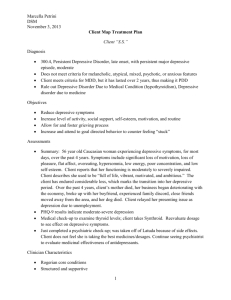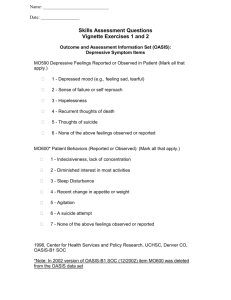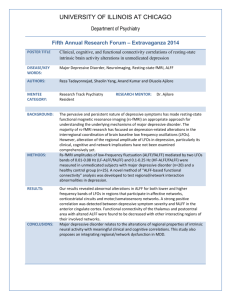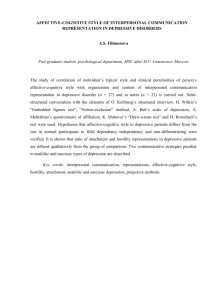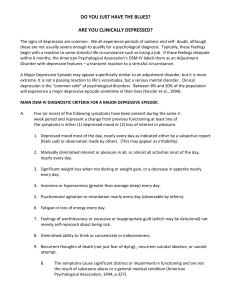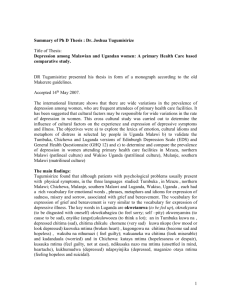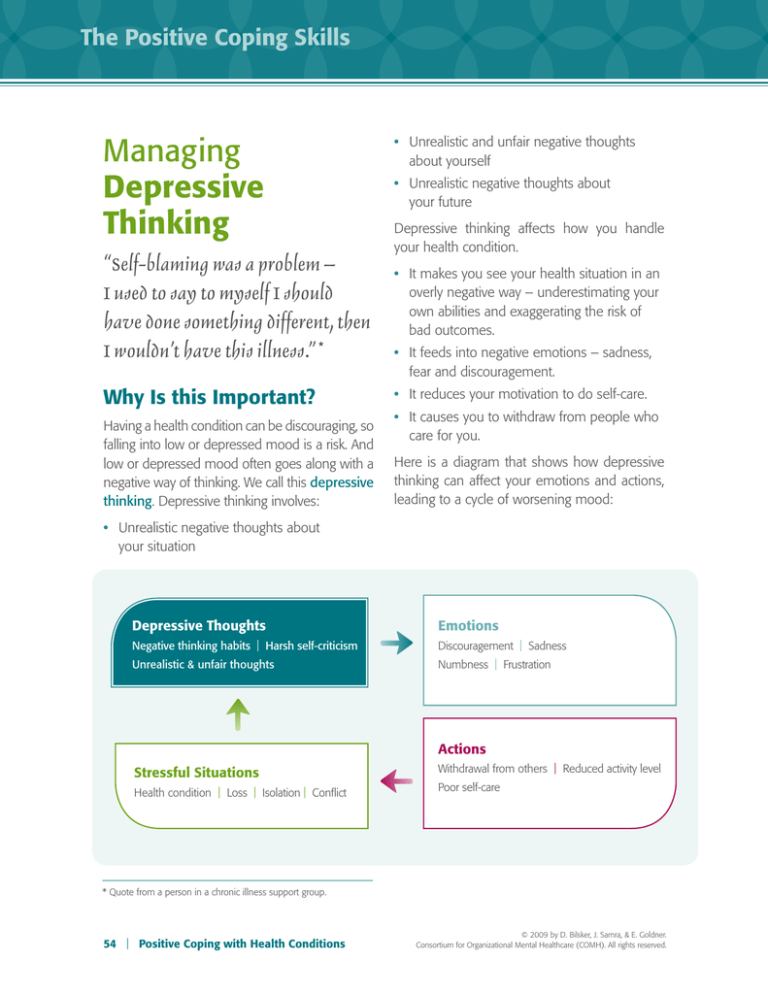
The Positive Coping Skills
Managing
Depressive
Thinking
“Self-blaming was a problem –
I used to say to myself I should
have done something different, then
I wouldn’t have this illness.” *
Why Is this Important?
Having a health condition can be discouraging, so
falling into low or depressed mood is a risk. And
low or depressed mood often goes along with a
negative way of thinking. We call this depressive
thinking. Depressive thinking involves:
• Unrealistic and unfair negative thoughts
about yourself
• Unrealistic negative thoughts about
your future
Depressive thinking affects how you handle
your health condition.
• It makes you see your health situation in an
overly negative way – underestimating your
own abilities and exaggerating the risk of
bad outcomes.
• It feeds into negative emotions – sadness,
fear and discouragement.
• It reduces your motivation to do self-care.
• It causes you to withdraw from people who
care for you.
Here is a diagram that shows how depressive
thinking can affect your emotions and actions,
leading to a cycle of worsening mood:
• Unrealistic negative thoughts about
your situation
Depressive Thoughts
Emotions
Negative thinking habits | Harsh self-criticism
Discouragement | Sadness
Unrealistic & unfair thoughts
Numbness | Frustration
Actions
Stressful Situations
Health condition | Loss | Isolation | Conflict
Withdrawal from others | Reduced activity level
Poor self-care
* Quote from a person in a chronic illness support group.
54 | Positive Coping with Health Conditions
© 2009 by D. Bilsker, J. Samra, & E. Goldner.
Consortium for Organizational Mental Healthcare (COMH). All rights reserved.
Managing Depressive Thinking
How Can I Change
Depressive Thinking?
The aim is to challenge depressive thinking and
replace it with realistic thinking.
Realistic thinking is:
• Accurate about your current situation (seeing
things as they are)
• Fair about yourself (balancing your view of
the positives and negatives in your life)
• Accurate about your future (not exaggerating
the chance of bad outcomes)
You can learn to evaluate your life situation and
yourself in a realistic manner. You can learn to
think in a fair and realistic way.
That means being fair and realistic about
yourself (paying attention to strengths as well
as weaknesses), about your current situation
(weighing the positive and negative accurately)
and about your future (not exaggerating the
chance of negative outcomes). On the next few
pages, we’ll explain how to change depressive
thinking into realistic thinking.
The steps toward Managing
Depressive Thinking are:
1.Identify Depressive Thoughts
2.Recognize how your Depressive
Thoughts trigger low mood
3.Challenge Depressive
Thoughts and replace them
with realistic ones
4.Practice realistic thinking
© 2009 by D. Bilsker, J. Samra, & E. Goldner.
Consortium for Organizational Mental Healthcare (COMH). All rights reserved.
1
Identify Depressive
Thoughts
When you have long-standing health problems,
it affects how you think about yourself and your
future. Many of your thoughts will be understandable and realistic, but others may reflect
depressive thinking. Knowing the difference between these kinds of thoughts is important.
Depressive Thoughts are unfair and unrealistic.
They are distorted – inaccurate reflections of
yourself and the world around you. The following
types of distorted thoughts are common in
people with depressed mood.
Types of Depressive Thoughts
Filtering
This means focusing on the negative and
ignoring the positive. Focusing on the negative
side of experiences can make your whole life
seem negative. For example, you receive the
results of a health checkup: even though most
of it is positive, you only remember the part
where “slightly overweight” was mentioned, so
you experience the checkup as mainly negative.
Realistic thinking balances both positive and
negative aspects of a situation.
Overgeneralizing
One negative event is seen to be the start of a
never-ending pattern. You may think that if you fail
the first time, you’ll fail every time. For example,
your appointment for a specialist treatment is
canceled and you start to think that it will never
happen and that you’ll never get the treatment
you require. Realistic thinking recognizes that
one disappointing outcome does not mean
everything will be disappointing.
Positive Coping with Health Conditions | 55
The Positive Coping Skills
catastrophe (unbearable suffering) rather than
to the smaller event (medium-level pain). Or,
you might think, “If I feel any pain with activity,
that means I’ve injured myself and I’d better stay
inactive.” Realistic thinking involves expecting
events according to their true likelihood, not
imagining the worst outcome.
Labeling
All-or-Nothing Thinking
You see the world in extremes. You are either
smart or stupid, tidy or a slob, entirely healthy
or totally ill. Situations are either wonderful
or terrible, successes or failures. There is no
in-between and gradual improvement is not
enough. For example, you start a new medication
and you feel better, but not like you felt before
getting sick, so you tell yourself that the treatment
has failed. Or you see your life now as totally
limited – you tell yourself that you really can’t
do anything enjoyable anymore. (And maybe
you imagine that your life before illness was
perfect). Realistic thinking involves seeing
situations and people as falling somewhere
between the extremes – toward the middle,
where most things are found. Even if your
life is more limited with a health condition,
there are usually interesting activities you
can still do or new activities you can start.
And, your life before the health condition
probably wasn’t perfect.
Catastrophizing
You view a difficult situation as a future disaster.
For example, you have back pain you rate as
medium, and you think, “In ten years it will
become unbearable.” You react to the imagined
56 | Positive Coping with Health Conditions
Labeling involves talking to yourself harshly
and calling yourself insulting names. You talk to
yourself in a way you would never talk to anyone
else. For example, you forget to take one of your
medications and blame yourself harshly, calling
yourself “idiot” and “useless.” Realistic thinking
avoids the use of insulting labels because
they are not fair. You wouldn’t talk to anyone
else that way, and it’s discouraging to do it
to yourself.
Mind-Reading
You feel as though you know what others are
thinking about you, and it’s always negative. As
a result, you react to what you imagine they
think, without checking. For example, you have
to use a cane to get around and you imagine
that everyone looks down on you. Realistic
thinking recognizes that guessing what others
think about you is likely to be inaccurate,
especially when your mood is down.
Fortune-Telling
You feel as though you know what the future will
bring, and it’s negative. Nothing will work out,
so why bother trying? For example, you don’t
take your medication regularly because you
tell yourself that it probably won’t help anyway.
Realistic thinking recognizes that you don’t
know how things will turn out. By staying
open to the possibility of positive results,
© 2009 by D. Bilsker, J. Samra, & E. Goldner.
Consortium for Organizational Mental Healthcare (COMH). All rights reserved.
Managing Depressive Thinking
you’ll be more hopeful and more likely to
achieve a positive outcome.
Perfectionism
It’s only good enough if it’s perfect – and since
you can’t make most things perfect, you’re
rarely satisfied or proud. For example, because
you can’t reach the same fitness goal as before
your health condition, you think it’s not worth
practicing rehabilitation exercises. Realistic
thinking gives credit for accomplishments,
even if the result is less than perfect. Few of
us reach perfection, but our achievements
are important.
Shoulds
You think that you know how the world should
be, and it isn’t like that. You know what you
should be like, and you aren’t. You know how
other people should behave, and they don’t.
As a result, you’re constantly disappointed and
angry. For example, you tell yourself that your
specialist should set aside half an hour for each
visit, but you actually get only 10 minutes – so
you feel bitter and discouraged. Realistic thinking
understands the limitations of the world and
of yourself – trying for improvement but also
accepting how things are. The world isn’t always
going to be fair and just.
There are other types of depressive thinking, but
these are the most common ones. When you
catch yourself thinking depressively, it can be
useful to look at this list to see if you are using
one of these styles of thinking. Most thinking
is so quick and automatic that we don’t even
realize we’re doing it. We must learn to become
aware of depressive thinking as it occurs. An
excellent strategy is to notice thoughts you are
having when you experience a drop in your
mood – it can be very helpful to write these
thoughts down.
Write down your Depressive Thoughts:
© 2009 by D. Bilsker, J. Samra, & E. Goldner.
Consortium for Organizational Mental Healthcare (COMH). All rights reserved.
Positive Coping with Health Conditions | 57
The Positive Coping Skills
2
Recognize How Your
Depressive Thoughts
Trigger Low Mood
Although low mood may seem like a dark cloud
hovering around you constantly, mood actually
shifts throughout the day. Every time your mood
sinks, ask yourself this important question:
“What was going through my mind just then?”
Pay attention to what you were thinking and
what you were reacting to. Write this down.
Perhaps you were leaving a medical clinic and
suddenly felt a deepening of your gloom. What
was going through your mind? Maybe your
doctor reminded you to do a self-care activity
and you thought, “Who am I kidding? I’ll never
be able to do that.”
If you record your thoughts for a period of time,
you will likely notice the same kinds of depressive
thinking, again and again. You might find yourself
placing a checkmark beside certain thoughts you
wrote down previously (“Oh, that one again!”).
When this happens, you have identified a
depressive thinking pattern. It’s helpful to write
down Depressive Thoughts and also exactly
what type of thoughts they are, using the Types
of Depressive Thoughts list above.
Example: Jack had been an enthusiastic athlete
since his teenage years. At the age of 56, he
began to experience pain in his joints and
loss of flexibility. He was eventually diagnosed
with arthritis. Despite medication, he was
forced to limit his physical activity. But much
of Jack’s social contact and enjoyment came
from playing tennis and golf with his friends. It
was a crushing blow for him to have to give up
these sports. He began to brood on Depressive
Thoughts like “I can’t do anything now, I’m just
a cripple, there’s really no point.” This kind of
thinking left him feeling very discouraged – his
mood became depressed.
He wrote down these Depressive Thoughts:
Depressive Thought
What Type of
Depressive Thought is this?
I can’t do anything now.
All-or-Nothing
I’m just a cripple.
Labeling
There’s really no point, nothing I do
seems worthwhile.
Overgeneralizing
58 | Positive Coping with Health Conditions
© 2009 by D. Bilsker, J. Samra, & E. Goldner.
Consortium for Organizational Mental Healthcare (COMH). All rights reserved.
Managing Depressive Thinking
Write some of your Depressive Thoughts here:
Depressive Thought
Then what? Some of your Depressive Thoughts
may seem obviously distorted: “Nobody
promised that treatment would take away all
my symptoms, so why did I expect that?” It can
be helpful just to know that your mind generates
depressive thinking in certain situations. Try to
become aware of the depressive thinking as it
happens and remind yourself where it comes
from: “I think this way because I feel sad and
discouraged.” You may find that you take
Depressive Thoughts less seriously once you
know why they arise.
© 2009 by D. Bilsker, J. Samra, & E. Goldner.
Consortium for Organizational Mental Healthcare (COMH). All rights reserved.
What Type of Depressive Thought is it?
When you become aware of your depressive
thinking you may be tempted to attack yourself:
“How could I think such stupid thoughts?”
Depressed mood causes you to be self-critical,
and recognizing depressive thinking can give
you one more reason to beat up on yourself.
Don’t. Instead, remind yourself that Depressive
Thoughts are the product of low mood and the
stress of living with a health condition.
Positive Coping with Health Conditions | 59
The Positive Coping Skills
3
hallenge Depressive
C
Thoughts and
Replace Them with
Realistic Ones
Now, it’s time to take a good look at each of
these Depressive Thoughts and challenge
them. Challenging depressive thinking means
that you figure out how these thoughts are
unfair or unrealistic and then find more fair and
realistic ways of thinking. In order to come up
with fair and realistic thoughts, it’s helpful to
work through the Reality Questions.
Depressive Thought:
I can’t do anything now.
? Reality Questions
Can I get more evidence, maybe by
asking someone about the situation?
It’s often helpful to get another person’s
opinion about the situation where you’ve been
experiencing low mood. For example, you tell a
clinic nurse that you’ve been feeling like you’ll
get worse and worse until you’re helpless. The
nurse reassures you that most people with
your health condition are able to stabilize their
symptoms and become increasingly active.
from another viewpoint, it’s easier to see how
your thoughts might be too negative.
What would I say to a friend, if my
friend were in a similar situation?
If a friend talked about feeling depressed in the
same situation, what would you say? You might
be able to help your friend think more fairly,
to look at the situation in a balanced way. You
might remind your friend of tough situations he
has handled successfully in the past. You might
find it easier to think fairly and realistically for a
friend than for yourself!
What will happen if I continue to think
this way?
It’s important to consider what will happen
if you continue thinking in a depressive way.
For example, what is the effect of depressive
thinking on your willingness to try new activities?
What will be the results for you and others if
you continue to think depressively?
What is a more encouraging or useful
way of thinking?
Can you come up with another thought that
would have better results for you and others?
Is there a way of thinking that would be more
encouraging and helpful in improving the situation?
Would most people agree with this
thought? If not, what would most
people think?
Just by imagining how most people would react
to a Depressive Thought, you might find a more
fair and realistic way of thinking. When you step
outside yourself and examine your thinking
60 | Positive Coping with Health Conditions
© 2009 by D. Bilsker, J. Samra, & E. Goldner.
Consortium for Organizational Mental Healthcare (COMH). All rights reserved.
Managing Depressive Thinking
Example:
This is how Jack answered the Reality Questions:
Can I get more evidence, maybe by
asking someone about the situation?
I’ve been so down that I haven’t really asked
about things I can do safely. I guess I could find
out what is possible from my physician or the
rehabilitation nurse.
Would most people agree with this
thought? If not, what would most
people think?
My wife tells me that I’m over-reacting. She
thinks I can find other physical activities, even if
they’re not quite as rewarding.
What would I say to a friend, if my
friend were in a similar situation?
What will happen if I continue to think
this way?
My mood has been dropping more and more,
and I’ve been less and less active. If I keep going
this way I won’t be able to do much at all.
What is a more encouraging or useful
way of thinking?
It would be helpful to focus on things I can still
do instead of things I can’t do. My golf and
tennis buddies are also getting older and they
might have to reduce their involvement in these
sports. Maybe they’d like to try some new kinds
of fitness activity.
Use this worksheet to come up with fair and
realistic thoughts to replace at least one of
your Depressive Thoughts:
I guess I wouldn’t be so hard on a friend.
I would be more hopeful.
Depressive Thought:
Can I get more evidence, maybe by asking someone about the situation?
> continued
© 2009 by D. Bilsker, J. Samra, & E. Goldner.
Consortium for Organizational Mental Healthcare (COMH). All rights reserved.
Positive Coping with Health Conditions | 61
The Positive Coping Skills
> Depressive Thought Worksheet
Would most people agree with this thought? If not, what would most people think?
What would I say to a friend, if my friend were in a similar situation?
What will happen if I continue to think this way?
What is a more encouraging or useful way of thinking?
62 | Positive Coping with Health Conditions
© 2009 by D. Bilsker, J. Samra, & E. Goldner.
Consortium for Organizational Mental Healthcare (COMH). All rights reserved.
Managing Depressive Thinking
Now think of a situation where you were feeling
down and discouraged. First, make a brief
note about the situation. Next, write down any
thoughts that made you feel sad or discouraged.
You might try to describe the type of Depressive
Thoughts you were having, by using the Types
of Depressive Thoughts list above. Finally,
think about the situation and try to come up
with more fair and realistic thoughts, using the
Reality Questions above.
Situation:
Depressive Thought
© 2009 by D. Bilsker, J. Samra, & E. Goldner.
Consortium for Organizational Mental Healthcare (COMH). All rights reserved.
Fair and Realistic Thoughts
Positive Coping with Health Conditions | 63
The Positive Coping Skills
4
Practice Realistic
Thinking
It’s not enough to come up with a fair and
realistic thought just once. Depressive thinking
gets repeated over and over, sometimes
for years, until it becomes automatic. More
balanced thinking will help you to feel better, but
it won’t be automatic – at least not for a while.
The good news is that changing depressive
thinking doesn’t take years. In fact, people with
low mood often notice a difference after a few
weeks of practicing realistic thinking.
Stressful situations can trigger
depressive thinking:
• Increase in physical symptoms or pain
• Forgetting to take your medication a
few times
• Visiting a new specialist for an opinion
about your care
In order to get the most benefit from practicing
realistic thinking, you must pay attention to your
thinking in stressful situations.
Write down a few situations where you often
have Depressive Thoughts.
Situations:
64 | Positive Coping with Health Conditions
When you find yourself in a stressful situation,
deliberately practice fair and realistic thinking.
Don’t assume it will happen on its own.
You have to tell yourself how to look at the
situation, just as you might give advice to a
friend. Talk back to the depressive thinking.
Don’t allow depressive thinking to happen
without replying to it. Every time you talk back,
you make the depressive thinking weaker and
the realistic thinking stronger. It takes time
before realistic thoughts have more influence
over you than depressive ones, but it’s well
worth the effort.
At first, realistic thinking might seem false
to you. If your thinking has been distorted
for some time, it can be difficult to see the
truth. Imagine that you’ve been thinking in an
unrealistic way about your health condition,
telling yourself “I have to go back to how
I was before this all started, or my life isn’t
worthwhile.” Having this thought regularly may
cause you to feel hopeless. You realize that
this is unrealistic thinking and come up with
the realistic thought “It is worthwhile to make
my life now as good as possible.” At first, this
realistic thought will seem false, as though
you’re just fooling yourself. Only with time
and repetition does realistic thinking – the
truth – begin to feel true to you. Eventually,
you’ll come to accept realistic thoughts more
naturally.
© 2009 by D. Bilsker, J. Samra, & E. Goldner.
Consortium for Organizational Mental Healthcare (COMH). All rights reserved.
Managing Depressive Thinking
Managing
Depressive Thinking:
Alex’s
Story
Alex was a married man in his mid-30s with two children, 10 and 14. He was employed as an
assistant bank manager. He had ulcerative colitis, diagnosed when he was 18 years old. This health
condition caused him to experience frequent nausea and gut pain. He managed the condition well
until his late 20s, but one day, he suddenly became ill and was rushed to the emergency room.
He needed surgery, followed by a two-week hospital stay. When Alex left hospital, he blanked the
whole experience from his mind and went back to his life. But the illness was going to be more
difficult to handle.
Over the next ten years, Alex had three more of these crisis situations, and each time was rushed
to hospital for emergency surgery. He found these hospitalizations frightening and depressing. After
each one, he put the experience out of his mind so he could focus on his job and family. Between
episodes, he would ignore symptoms, telling himself that it would be “weak” to let symptoms limit
his activities.
After his fourth hospitalization, Alex’s physician referred him to a self-management group and gave
him a copy of this workbook. As he read through the book, he realized two things. First, when
he was very stressed at work, the health condition worsened. Second, he was ignoring the early
warning signs that the illness was becoming worse. When symptoms intensified, he would plunge
into his job, telling himself that it would be weak and cowardly to let the health condition run his
life. But as a result, he wasn’t taking early action to manage the illness before it worsened. Other
> continued
© 2009 by D. Bilsker, J. Samra, & E. Goldner.
Consortium for Organizational Mental Healthcare (COMH). All rights reserved.
Positive Coping with Health Conditions | 65
The Positive Coping Skills
> Managing Depressive Thinking: Alex’s Story
people in the self-management group showed him that if he recognized early warning signs, he
could temporarily increase the medication or reduce stress and maybe prevent hospitalization.
He identified one particular Depressive Thought that often repeated and made it difficult to deal
with the symptoms: “You just can’t handle the pressure, you want people to take care of you.” This
thought made him feel guilty whenever he had to take a rest from his job because of symptoms –
he would force himself to get right back to work.
Alex used Managing Depressive Thinking to change the way he was thinking about his health condition.
Situation: I have a flare-up of my colitis symptoms, pain and nausea. I have to take a break.
Depressive Thoughts
You just can’t handle
the pressure.
You want people
to take care of you.
(Perfectionism; Labeling)
Fair & Realistic Thoughts
• I’ve never expected others to take care of me, but sometimes
I need support and that’s fair.
• Speaking to myself in this harsh way leaves me feeling more
tense and discouraged; it doesn’t help me deal with the illness.
• If I keep ignoring my symptoms, the illness will get worse until
I have to go back into hospital – that will really affect my work
and family.
• I have the right to take care of my health – if I notice early
warning signs and take action, it’s more likely that I can stay out
of hospital, which is good for my job and family.
Then, Alex set up a prevention plan. This involved writing down:
1.Early warning signs
2.Steps to take when I notice these signs
• His doctor helped him to work out a medication plan
• He practiced the Relaxation skill to better handle job stress
3.Who to call for help
• His wife, parents, physician and in certain situations his boss.
As he applied this prevention plan, Alex was happy to find that it gave him a greater sense of control. He
still had to manage the pain and symptoms, but it was years before he saw the inside of a hospital again.
66 | Positive Coping with Health Conditions
© 2009 by D. Bilsker, J. Samra, & E. Goldner.
Consortium for Organizational Mental Healthcare (COMH). All rights reserved.

